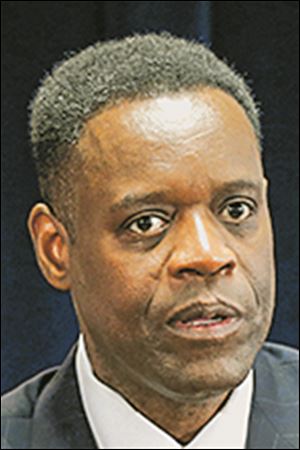
EDIOTRIALS
Detroit’s lessons
5/16/2013
Orr
Toledoans can take comfort in the fact that their city’s finances are not like Detroit’s. But not too much comfort, because what happens in Detroit affects not only the entire state of Michigan, but also neighboring northwest Ohio.
And if Detroit should go bankrupt or endure some other fiscal catastrophe, our region will feel the tremors.
In a report this week, Detroit’s new emergency manager, Kevyn Orr, stated the obvious: “Continuing along the current path is an ill-advised and unacceptable course of action if the city is to be put on the path to a sustainable future.”
Detroit has a general fund of $1 billion a year and a total budget of about $2.5 billion. Yet it has obligations, largely unfunded, of at least $15 billion, Mr. Orr calculates. Since 2008, the city has spent $100 million more a year than it has taken it, although it supposedly is required by law to balance its budget. It keeps cash on hand only by not paying some bills; Mr. Orr says the city is “clearly insolvent.”
Detroit’s credit rating is in junk-bond territory — the lowest in its history and the worst of any major U.S. city. But it hardly matters, because Detroit has reached its legal debt limit and can’t borrow more money anyway.
While it was mortgaging its future, Detroit allowed its public infrastructure and services — police and fire protection, ambulances, street lights and electric grid, water and sewer network, road and bridge maintenance, bus routes, parks and recreation centers — to deteriorate. Blight and abandoned houses plague once-solid neighborhoods across the city. Mr. Orr concludes: “The city’s operations have become dysfunctional and wasteful after years of budgetary restrictions, mismanagement, crippling operational practices and, in some cases, indifference or corruption.”
Detroit hasn’t shrunk physically; it still sprawls over 139 square miles — an area Mr. Orr notes is larger than Manhattan, Boston, and San Francisco combined. But it has barely one-third the number of residents it had at its population peak of 1.85 million in 1950 (it has about 2.4 times the population of Toledo today).
Detroit’s official unemployment rate has tripled since 2000, to 18.3 percent (the real rate is often estimated at close to 50 percent). Crime rates are high. As middle-class families have fled the city, its income and property tax collections are way down. Similar to Ohio, an unsympathetic state government has slashed aid to the city.
Mr. Orr doesn’t say so explicitly, but Detroit’s fiscal crisis is largely the result of reckless pension and health-insurance commitments that previous city officials made to municipal workers. Such commitments may have bought temporary labor peace, but at a price that these officials knew or should have known could not ultimately be sustained.
Today, after waves of layoffs, there are two retired city workers for every active one. The overworked few who remain have endured repeated pay and benefit cuts. Yet Detroit has stopped contributing to its pension funds, relying instead on notes that are little more than IOUs.
What will happen if — when — tens of thousands of current, retired, and laid-off employees are told that Detroit cannot afford to keep the promises on which many of them based their plans for a secure retirement? It isn’t pretty to contemplate, but it’s a cautionary tale that many other communities and states — including Ohio — that continue to defer their own pension issues must hear.
It’s hard to see at this point how Detroit can right itself fiscally without the sort of wrenching restructuring that only a managed bankruptcy can provide, similar to what General Motors and Chrysler went through in the private sector four years ago. Some city officials argue for emergency federal aid, but whatever the merits of that argument, it is finding no support in Washington.
If there is a less drastic alternative to bankruptcy, Mr. Orr needs to find it. He speaks of privatizing some services, or regionalizing them, or shifting them to third-party operators, or creating independent trusts. But whatever he proposes, he is surely correct that Detroit can neither revitalize itself, make itself safe, nor attract private investment until it has a stable financial foundation and a manageable long-term debt load.
The scale of Detroit’s fiscal problems is nearly inconceivable, but these problems once differed from other cities’ more in degree than kind. Candidates in this year’s campaigns for Toledo mayor and City Council could usefully discuss — in detail — what they will do to prevent our city from coming to resemble a smaller Detroit.